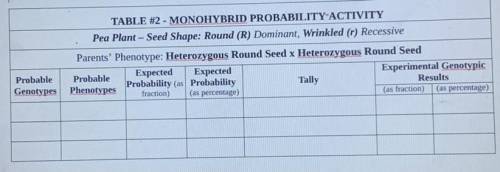30 points Plzzz help
1. Complete the "Table #1" Punnett square for the possible offspring.
2....

Biology, 28.01.2021 09:00 jasoncarter
30 points Plzzz help
1. Complete the "Table #1" Punnett square for the possible offspring.
2. After completing the Punnett square in "Table #1", move on to "Table #2". In "Table #2" you are now able to fill in "Probable Genotypes" of the
offspring, "Probable Phenotypes" of the offspring, and "Expected Probability" of the offspring. When you are completing the "Expected
Probability" of the offspring, you are to record the probability as a fraction and percentage. (Example: If the fraction from the Punnett square for a
certain genotype is 1/4 then do 1 divided by 4 to calculate the percentage which would be 25%.)
3. The two coins represent the two parents. One coin for one parent and the other coin for the other parent. Remember that each parent has two alleles for each
characteristic: R and r. One coin, representing one parent, has two sides, one side for one allele and the other side for the other allele. Attach a piece of masking tape to
each side of both coins. On one side of each coin write the one allele each parent has: R and R. On the other side of the same coins, write the other allele each parent
has: r and r. (When you finish this step you should have two coins with "R" on one side and "" on the other side.)
4. You will now simultaneously flip the two coins and record the result of the flip. Record the result of the flip, by writing a tally mark, slash, or check, under the
tally" column of Table #2 in the row of the genotype that the flip matches. Flip the two coins simultaneously for a total of 20 flips.
5. After flipping the two coins 20 times, add your tallies for each genotype, or row. Record the number of tallies (for each of the three genotypes) over 20 in the
***Experimental Genotypic Results - as fraction" column (ex. 8/20). After recording the fractions of your data, divide your fractions and record the percentages in the
column labeled "Experimental Genotypic Results - as percentage".


Answers: 1


Another question on Biology

Biology, 21.06.2019 22:00
Cell specialization occurs by the process ofa. reproductionb. differentiationc. maturationd. growth
Answers: 2

Biology, 22.06.2019 02:00
Consider the motion of the balloon and its air contents in terms of momentum. in step 1 above, the total momentum of the balloon and its contents was zero. recall that momentum = mv. both the balloon and the air inside it had a velocity of zero and therefore the total momentum was zero. now think about what happened when the air escaped from the balloon. a certain mass of air accelerated in one direction. in order to keep the total momentum of the system zero, the balloon itself (which has mass) had to accelerate in the opposite direction. use this scenario to you explain why the soda can rotates when the water squirts out of the escape holes. what was your hypothesis concerning the water-filled can? according to your data, do you think your hypothesis was correct? (be sure to refer to your data when answering this question.) summarize any difficulties or problems you had in performing the experiment that might have affected the results. describe how you might change the procedure to avoid these problems. give at least one more example of newton's third law in everyday life.
Answers: 1

Biology, 22.06.2019 06:30
Which of the following is a common response to cell signaling?
Answers: 2

You know the right answer?
Questions



Mathematics, 18.12.2020 08:10

Business, 18.12.2020 08:10




Mathematics, 18.12.2020 08:10

Mathematics, 18.12.2020 08:10




Mathematics, 18.12.2020 08:10


Mathematics, 18.12.2020 08:10


Mathematics, 18.12.2020 08:10



Mathematics, 18.12.2020 08:10



